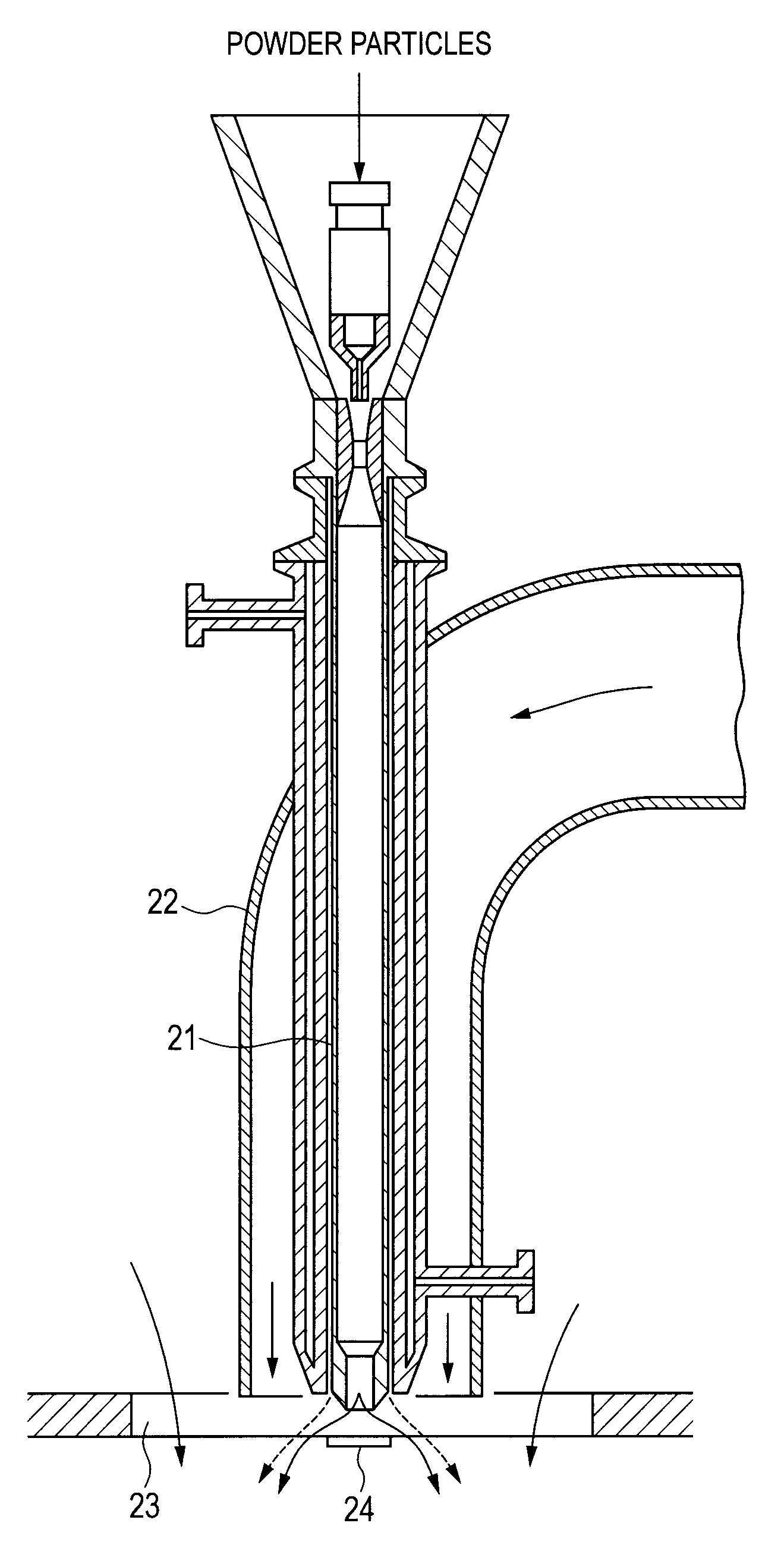Heat treatment apparatus and method for manufacturing toner
a technology of heat treatment apparatus and toner, which is applied in the direction of heating apparatus, lighting and heating equipment, instruments, etc., can solve the problems of reducing the cleanability, reducing the efficiency of toner production, and affecting the quality of toner, so as to suppress the ratio of particles, reduce the amount of fine powder, and reduce the effect of spheroidization
- Summary
- Abstract
- Description
- Claims
- Application Information
AI Technical Summary
Benefits of technology
Problems solved by technology
Method used
Image
Examples
example 1
[0099]Powder particles were heat-treated with the use of a heat treatment apparatus illustrated in FIGS. 1A to 1C.
[0100]In the apparatus used in the present exemplary embodiment, a hot-air supply unit and a first nozzle were integrally formed. A louver was provided between a first nozzle and a second nozzle in the outlet portion of the hot-air supply unit so that thereby hot air flowed while spirally rotating along the inner wall face of the apparatus. Furthermore, in the cross-section of the apparatus, an angle formed by the ridge line of the first nozzle (angle spreading toward the downstream side from the upstream side of the apparatus) was set at 40 degrees, an angle formed by the ridge line of the second nozzle was set at 60 degrees, and a return portion was provided on the lower end of the second nozzle. An angle formed by the ridge line of the return portion was set at 140 degrees.
[0101]The powder particles A were heat-treated so that the average degree of circularity of the ...
example 2
[0130]Powder particles A were heat-treated with the use of an apparatus illustrated in FIG. 2. The apparatus used in the present exemplary embodiment had such a structure that an adjustment portion of a raw-material supply unit was removed from the apparatus used in the Exemplary Embodiment 1.
[0131]The powder particles A were heat-treated so that the average degree of circularity of the powder particles A after having been heat-treated became 0.970, by using the apparatus having the above described structure.
[0132]As for the operation conditions at this time, the feed amount (F)=15 kg / hr, the temperature of hot-air (T1)=160° C., the quantity of hot-air (Q1)=10.0 m3 / min, the total quantity of cold-air 1 (Q2)=4.0 m3 / min, the total quantity of cold-air 2 (Q3)=4.0 m3 / min, the quantity of a compression gas (IJ)=1.5 m3 / min, the air quantity of a blower (Q4)=21.5 m3 / min, and the operation period of time was set at 1 hour.
[0133]These operation conditions were summarized in Table 1.
[0134]As ...
example 3
[0139]The apparatus used in the present exemplary embodiment was provided with a second nozzle having a shape (having ribs provided in the end of the nozzle and having no return portion) illustrated in FIG. 3. The apparatus had the same structure as the apparatus used in Exemplary Embodiment 1, except the above point.
[0140]The powder particles A were heat-treated so that the average degree of circularity of the powder particles A after having been heat-treated became 0.970, by using the apparatus having the above described structure.
[0141]As for the operation conditions at this time, the feed amount (F)=15 kg / hr, the temperature of hot-air (T1)=170° C., the quantity of hot-air (Q1)=10.0 m3 / min, the total quantity of cold-air 1 (Q2)=4.0 m3 / min, the total quantity of cold-air 2 (Q3)=4.0 m3 / min, the quantity of a compression gas (IJ)=1.4 m3 / min and the air quantity of a blower (Q4)=21.0 m3 / min, and the operation period of time was set at 1 hour.
[0142]These operation conditions were sum...
PUM
| Property | Measurement | Unit |
|---|---|---|
| weight average particle diameter | aaaaa | aaaaa |
| weight average particle diameter | aaaaa | aaaaa |
| particle diameter | aaaaa | aaaaa |
Abstract
Description
Claims
Application Information
 Login to View More
Login to View More - R&D
- Intellectual Property
- Life Sciences
- Materials
- Tech Scout
- Unparalleled Data Quality
- Higher Quality Content
- 60% Fewer Hallucinations
Browse by: Latest US Patents, China's latest patents, Technical Efficacy Thesaurus, Application Domain, Technology Topic, Popular Technical Reports.
© 2025 PatSnap. All rights reserved.Legal|Privacy policy|Modern Slavery Act Transparency Statement|Sitemap|About US| Contact US: help@patsnap.com



